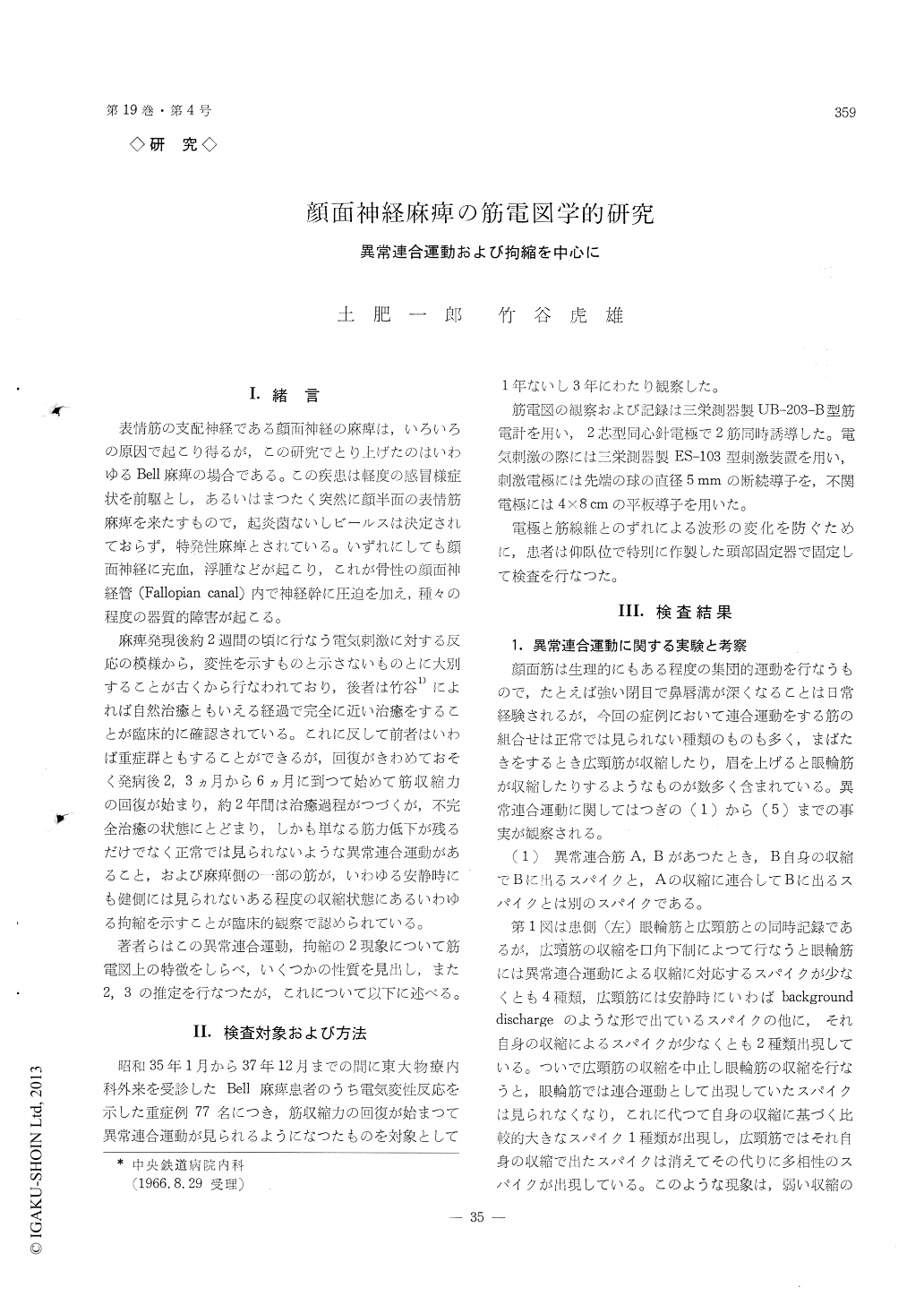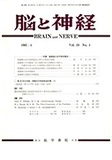Japanese
English
- 有料閲覧
- Abstract 文献概要
- 1ページ目 Look Inside
I.緒言
表情筋の支配神経である顔面神経の麻癖は,いろいろの原因で起こり得るが,この研究でとり上げたのはいわゆるBell麻痺の場合である。この疾患は軽度の感冒様症状を前駆とし,あるいはまつたく突然に顔半面の表情筋麻痺を来たすもので,起炎菌ないしビールスは決定されておらず,特発性麻痺とされている。いずれにしても顔面神経に充血,浮腫などが起こり,これが骨性の顔面神経管(Fallopian canal)内で神経幹に圧迫を加え,種々の程度の器質的障害が起こる。
麻痺発現後約2週間の頃に行なう電気刺激に対する反応の模様から,変性を示すものと示さないものとに大別することが古くから行なわれており,後者は竹谷1)によれば自然治癒ともいえる経過で完全に近い治癒をすることが臨床的に確認されている。これに反して前者はいわば重症群ともすることができるが,回復がきわめておそく発病後2,3ヵ月から6ヵ月に到つて始めて筋収縮力の回復が始まり,約2年間は治癒過程がつづくが,不完全治癒の状態にとどまり,しかも単なる筋力低下が残るだけでなく正常では見られないような異常連合運動があること,および麻痺側の一部の筋が,いわゆる安静時にも健側には見られないある程度の収縮状態にあるいわゆる拘縮を示すことが臨床的観察で認められている。
The strange phenomena of abnormal associated mo-vements and contracture of facial muscles are often observed in the convalescence of severe cases of Bell's palsy. The authors have studied electromyographically the wave form and discharge interval of the action potentials (APs) and following results are obtained.
(1) The AP recorded during the voluntary cont-raction of a certain muscle is different from the APs that appear in the abnormal associated movement of the same muscle.
(2) During the strong contraction of some facial muscles, APs appear in other group of muscles as the result of normal associated movement. These APs are same as those observed in the early stage of voluntary contraction of the latter muscles.
(3) While the orbicularis oculi reflex is evoked during the voluntary eye closure, the discharge inter-val of the AP recorded in the orbicularis oculi or in the other muscles that contract as the result of abnor-mal associated movement at first shortens and leng-thens. Such relations are not observed regarding the discharge interval of the AP recorded in the orbicul-aris oculi during its abnormal associated movements.
(4) When a certain facial muscle is stretched during its voluntary contraction, the discharge inter-val of the AP recorded in the same muscle or those expressing the abnormal associated movements shor-tens during the stretch. But the stretching of the latter muscles never induce such changes.
(5) Electrical stimulation of a branch of facial nerve with the current strength of 10% more than the threshold sometimes evoked an AP in some mus-cles innervated with another branch of this nerve. For example, an AP appears in the orbicularis oculi muscle while the branch to the depressor labii infe-rioris is stimulated near the mandibular angle. The voluntary reproduction of this AP was only possible with the voluntary contraction of the latter muscle.
The above-mentioned observations from (1) to (5) confirm the existence of misdirection or impulse lea-kage in the site of lesion thus explaining the occuren-ce of abnormal associated movements.
(6) Though the site of lesion of Bell's palsy is in the peripheral nerve fibre, the strange phenomenon of contracture is often observed and the mechanism has never been explored electromyographically. We found two kinds of APs in such an abnormal state. The frequency of some APs recorded at rest increases during the voluntary contraction of the same muscle, but there remain APs that do not change the dis-charge frequency during the voluntary contraction. At least two mechanisms are estimated from the electro-myographic findings,one being the remaining activity of some neurons at rest and the other the abnormal associated movement with basic contraction of other portions of facial muscle, for example, the orbicularis oris muscle.
(7) The authors add a few strange findings the coupled spikes, spike burst during rest and volition, and high-frequency discharge which lasts for about fifteen seconds.
The coupled spikes are easily recorded in almost all of our materials. Each spike often took the polyphsic form and the interval of two spikes was between 5 to 15 milliseconds. These coupled spikes change their discharge frequency according to the grade of volun-tary contraction. At least two mechanisms may be estimated to explain this phenomenon. One is the synchronized activity of the two motoneurons and another is the branching of nerve fibres.
In one case spike burst was observed consisting of repetition of the same AP. This burst appears in the same manner both at rest and during voluntary cont-raction. As the burst disappears in the pentobarbi-turate anesthesia while the orbicularis oculi reflex remains, this phenomenon should be explained with the increased motoneuron excitability and can not be explained as the irritation at the site of lesion.
The high frequency discharge was the repetition of a polyphsic potential of normal amplitude. Therefore this phenomenon is different from the usual myotonic potential and can be regarded as the expression of increased excitability of motoneurons.
From these findings described in (6) and (7), we should assume some kinds of increased excitability of facial motoneuron in our materials. The authors presume the increase of impulse in the upper motone-uron as the important factor, because in facial palsy the loss of motor function in the diseased side is al-ways noticed with the unaffected sensible function.

Copyright © 1967, Igaku-Shoin Ltd. All rights reserved.


